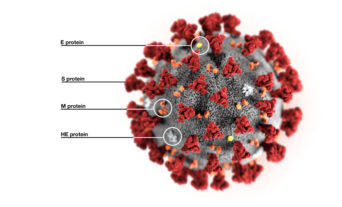‘it was a most surprising thing, to see those streets, which were usually so thronged, now grown
desolate, and so few people to be seen in them’
– Daniel Defoe, A Journal of the Plague Year (1722)
The detection of an outbreak of pneumonia caused by an unknown pathogen in Wuhan, China, in December 2019 signalled the start of a cataclysm that has swept the world. Events have moved with astonishing speed. The World Health Organisation (WHO) China Country Office was notified of clusters of cases of pneumonia on 31 December 2019,1 the same day that a rapid response team was sent to Wuhan from the Chinese Centre for Disease Control and Prevention in Beijing to assist local health authorities investigate the outbreak.2 Epidemiological inquiries implicated the local seafood and wet animal wholesale market as the origin of the infection, and this was closed on 1 January 2020. A novel coronavirus, of probable bat origin, was isolated from infected patients on 7 January and the genetic sequence of this virus was published on 12 January.2 The recognition that this virus could be transmitted from person to person and that it caused severe or fatal disease in a high proportion of patients created mounting global apprehension as the infection spread first through China, then to other countries in Asia and subsequently to every part of the world.
The speed at which the infection swept across the globe is highlighted by the rapidly changing position taken by the WHO. On 29 February, Dr Michael Ryan, executive director of the WHO Health Emergencies Programme said,3 ‘If we say there is a pandemic of coronavirus we are essentially accepting every human on the planet will be exposed to that virus and the data does not support that as yet.’ A global pandemic was declared by WHO on 11 March.4
Almost certainly there were earlier missed infections.
The first two cases diagnosed in the UK were announced on 31 January 2020.5 The pair, Chinese nationals, were probably already infected when they entered the UK. The first identified case of infection acquired in the UK was diagnosed on 28 February.3 Almost certainly there were earlier missed infections.
Since the first UK COVID-19 death on 5 March, over 45,000 deaths have been attributed to the infection in the UK.6 We have become used to the daily announcements of hundreds of COVID-19 deaths. It might be sobering to recall that the official death toll of the 2013–2016 Western Africa Ebola virus epidemic, seen rightly as an overwhelming humanitarian crisis, was 11,323.
The rapid identification and characterisation of SARS-CoV-2 within days of the initial reports of the first clinical cases is a remarkable achievement.
The explosion in the spread of infection around the globe has been mirrored by the growth in publications about the SARS-CoV-2 virus, COVID-19 and consequences of infection. At the time of writing, there are 2,737 pre-print manuscripts on medRxiv, 671 on bioRxiv and 12,563 articles addressing the infection listed on Medline. The rapid identification and characterisation of SARS-CoV-2 within days of the initial reports of the first clinical cases is a remarkable achievement. However, it is becoming obvious that the rush to publish by other authors has led to claims and conclusions that just a month or two later are clearly not sustainable. For example, an early analysis of the genomic and protein structure of SARS-CoV-2 concluded, ‘these findings suggest that the new virus does not readily transmit between humans and should theoretically not [be] able to cause very serious human infection.’7
Many other questionable beliefs have been promulgated, including the fiction that 5G data networks weaken immune systems and increase susceptibility to COVID-19.8 Arguably more dangerous was a belief that was fundamental to initial UK public health policy, that COVID-19 infection would produce long-lasting protective immunity that would bring the outbreak under control. At the time of writing, the prospect of long-term immunity is not certain and precedents from other coronaviruses are not encouraging.9
To say that the NHS managed to cope with the outbreak, even by the skin of its teeth, is a misrepresentation. There was poor preparedness for the pandemic despite the opportunity to learn from Exercise Cygnus.10 Many patients were denied intensive care and the possibility of survival, however small. The delivery of personal protective equipment was erratic and jeopardised the lives of front-line NHS staff. The stock of FFP3 respirators that was delivered changed every week, making fit-testing impractical. When it was carried out, some FFP3 devices had a 100% fit-test failure rate. Over 120 NHS and social care workers have died of infection, a burden that has been especially heavy for black and minority ethnic staff. While not all of these infections will have been acquired occupationally, there will remain the concern that some of these deaths could have been avoided.
Now, after nearly two months of lockdown and deserted streets, the country appears to be past the peak of the outbreak. However, the need to restore in-patient care for non-COVID-19 patients while still admitting COVID-19 patients is the next challenge; the risk of acquiring infection is now greater inside hospitals than in the community and few UK hospitals have anywhere near enough single occupancy rooms to allow effective infection prevention. The lack of availability of rapid SARS-CoV-2 testing capacity compounds the difficulties. By the time this Bulletin is published, the country may be in the grip of a second wave of infection…or COVID-19 may have died out. Either way, the articles in this edition will be a valuable record of a new plague year.
References
- World Health Organisation. Novel coronavirus (2019-nCov). Situation Report − 1. Published 21 January 2020. Available at: www.who.int/docs/default-source/coronaviruse/situation-reports/20200121-sitrep-1-2019-ncov.pdf?sfvrsn=20a99c10_4
- Zhu N, Zhang D, Wang W, Li X, Yang B, Song J et al. A Novel Coronavirus from Patients with Pneumonia in China, 2019. N Engl J Med 2020;382:727–733.
- BBC News. Coronavirus: Latest patient was first to be infected in UK. Available at: www.bbc.co.uk/news/uk-51683428
- World Health Organisation. Coronavirus disease 2019 (COVID-19). Situation Report – 51. Available at: www.who.int/docs/default-source/coronaviruse/situation-reports/20200311-sitrep-51-covid-19.pdf?sfvrsn=1ba62e57_10
- BBC News. Coronavirus: Two cases confirmed in UK. Available at: www.bbc.co.uk/news/health-51325192
- Gov.uk. Coronavirus (COVID-19) in the UK. Available at: https://coronavirus.data.gov.uk/
- Dong N, Yang X, Ye L, Chen K, Chan EW-C, Yang M et al. Genomic and protein structure modelling analysis depicts the origin and infectivity of 2019-nCoV, a new coronavirus which caused a pneumonia outbreak in Wuhan, China. bioRxiv 2020;doi:10.1101/2020.01.20.913368. Available at: http://biorxiv.org/lookup/doi/10.1101/2020.01.20.913368
- BBC News. Coronavirus: Scientists brand 5G claims ‘complete rubbish’. Available at: www.bbc.co.uk/news/52168096
- Kirkcaldy RD, King BA, Brooks JT. COVID-19 and Postinfection Immunity: Limited Evidence, Many Remaining Questions. JAMA 2020;doi:10.1001/jama.2020.7869. Available at: https://jamanetwork.com/journals/jama/fullarticle/2766097
- The Guardian. What was Exercise Cygnus and what did it find? Available at: www.theguardian.com/world/2020/may/07/what-was-exercise-cygnus-and-what-did-it-find




